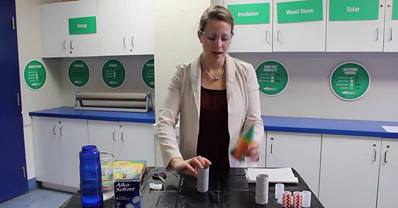
Have you ever wondered how to make rockets at home? This science experiment is a fun activity to do any time of year. Do you have some old film canisters lying around your house? Here’s a way to tell your kids a little history about film, and a fun way to re- use film canisters.
See how carbon dioxide bubbles are used to blast off a rocket in 3, 2, 1, blast off!!!
What you will need is a film canister with a snap-on lid, Alka-Seltzer tablets (or ENO antacid), water, watch or timer, safety glasses, notebook, empty paper towel roll or a similar sized tube, construction paper, duct tape, paper towel and a garbage bag.

To make these homemade Rockets you will first need to put on your safety glasses. Cover your work area with a garbage bag and have paper towel handy. Next, break the Alka-Seltzer tablets into four equal pieces and fill the film canisters one-half full of water. Place one of the Alka-Seltzer pieces in the film canister. What happens? Time it to see how long the liquid bubbles? Once the liquid is done bubbling, dispose of the liquid. Next, repeat the experiment but this time, place the lid on the canister and flip it over so the lid is on the surface of the table. Remember to start timing the reaction as soon as you drop the Alka-Seltzer tablet in the canister and stand back! The lid should pop off and the rest of the canister will shoot up into the air. To take this experiment further, you can change the temperature of the water, add more or less water or make more than one rocket blast off at a time. You can also design your own rocket by using construction paper, tape and a paper towel roll to go over the film canister. See how far the rocket flies by recording its distance. Check out our video of this experiment for the step-by-step instructions and to see our rocket blast off!

So what’s happening? The secret is hidden in the bubbles. The Alka-Seltzer tablets (or ENO) contain Sodium Bicarbonate (baking soda) and Citric Acid, and when they are added to water they produce bubbles of carbon dioxide gas. When the lid is put on the canister the carbon dioxide builds up and creates enough pressure to force the sealed canister open. Newton’s Third Law, which states that for every action there is an equal or opposite reaction, explains why the canister flies up in the air. The lid goes one way and the film canister shoots out in the opposite direction.
Need more creative and educational outlets for your kids? Then bring them into the Discovery Centre for hours of interactive fun including our newest exhibit Animal Grossology – a stinky, slimy, scaly, squishy experience you won’t want to miss!
For more great things to discover – visit the Discovery Centre on Barrington Street in Halifax, check out their website or join them on facebook

